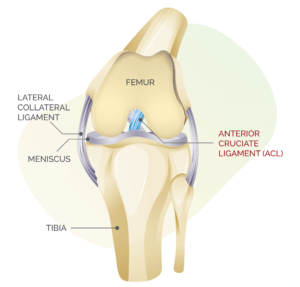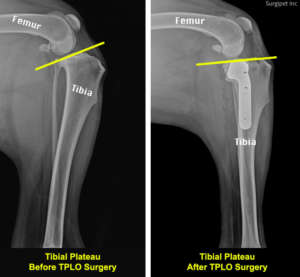Pet Orthopedic Surgery
Find out why TPLO Surgery is the best option for dogs with a torn cruciate ligament
Cruciate Ligament (ACL) Rupture in Dogs

The dog’s knee (sometimes called the stifle joint) is comparable to a human’s knee. The knee is a joint between the femur (top) and the tibia (bottom bone). The anterior (cranial) cruciate ligament (ACL) is located inside the joint and stabilizes the joint. One of the essential functions of the ligament is to keep the top bone (the femur) movement in alignment with the movement of the bottom bone (the tibia). This makes both bones work in unison when the knee is bend.
Anterior cruciate ligament (ACL) tear or rupture is the most common knee injuries we treat at Surgipet. In most dogs, the ACL injury is due to long-term degeneration, whereby the fibers within the ligament fail over time. This problem affects all ages and breeds of dogs, and rupture of the ACL in both knees is common. In fact, 54-60% of dogs will tear the cranial cruciate ligament of the other knee within 3 years.
Signs of Torn Cruciate Ligament in Dogs
Clinical signs of the early ACL damage include stiffness of the leg or very mild limping. As the disease progresses, the limping becomes more visible. Some dogs initially show no discomfort or limping and then become very painful and start obviously limping after running in the park or chasing the ball. With a complete break of the ACL, the dogs initially do not use the leg at all (keeping it up), but they will start using it cautiously as time goes on. In a large breed dog, the limping seldom resolves without surgery.
Why is it important for a veterinary orthopedic surgeon to evaluate a dog with a suspected torn ACL?
For several reasons, a veterinary orthopedic surgeon needs to evaluate a dog with a suspected torn anterior cruciate ligament (ACL).
First, a veterinary orthopedic surgeon is a specialist who is highly trained and experienced in diagnosing and treating injuries and conditions of the bones and joints. This expert knowledge and experience can help to ensure that your pet receives an accurate diagnosis and the most appropriate treatment for their condition.
Second, a veterinary orthopedic surgeon can develop a comprehensive treatment plan to manage your dog’s condition and improve their long-term outlook. This includes helping you choose the optimal surgical technique for the torn cruciate ligament and creating a postoperative plan to ensure smooth and complete recovery.
Working with a veterinary orthopedic surgeon can help ensure that your dog receives the best possible care for their condition.
Surgical Options for Dogs With Torn Cruciate Ligament (ACL Tear)
There are several surgical options for treating a torn anterior cruciate ligament (ACL) in dogs. The most common and effective option is a technique called a tibial plateau leveling osteotomy (TPLO).
In some cases, our orthopedic surgeon may also recommend other surgical options, such as a tibial tuberosity advancement (TTA) or a lateral suture stabilization (LSS). These techniques involve using specialized implants or sutures to stabilize the knee joint and support the damaged ligament.
Our orthopedic surgeon can help you choose the best surgical option for your dog based on its individual circumstances. They will consider factors such as the dog’s age, size, overall health, the extent of the injury, and any underlying conditions.
TPLO (Tibial Plateau Levelling Osteotomy) Surgery Is The Best Option to Treat Ruptured ACL In Dogs

The first part of the surgery involves removing the torn ends of the ACL and examining the menisci (two unique “cushions” inside the knee). If the meniscus is damaged, the surgeon will remove part or all of it. The second part of the surgery involves making a unique cut into the top of the tibia and then rotating the top, so the tibial plateau (pictured as yellow line on radiographs) is flatter.
A stainless steel or titanium plate and screws are placed to hold the tibia in a more natural angle. This helps to stabilize the knee joint and prevent the forces that caused the ACL tear from continuing to damage the joint.
How do I take care of my dog after TPLO surgery?
TPLO Surgery performed by our expert team is only the first step to a successful outcome. The second step, recovery, relies on the pets’ parents:
- Prescribed medications should be given as outlined in the written instructions. These medications ensure that the pain is well controlled and infection risk remains minimal. In addition, dogs may require sedatives if they are too active.
- Exercise must be restricted. Walking on the operated leg will not hurt the surgery site, but any other activity (running, jumping, playing) is very dangerous. In the second stage of recovery following TPLO Surgery, rehab exercises at home or through physical therapy can hasten the healing process.
- Protect the surgical incision using an Elizabethan collar, Lick Sleeve, or both for the first two weeks after TPLO surgery.
Detailed information on recovery following orthopedic surgery including TPLO in dogs can be found in our Recovery Room.
Recovery After TPLO surgery: Timeline
Unlike the healing from other techniques used for ACL tear, TPLO surgery recovery is generally more rapid and absolute. In our practice, about half of the dogs will start to cautiously walk on the operated leg within 48 hours after the surgery. Five days after the surgery, most dogs will put some weight on the operated leg. By 2 weeks, the amount of weight placed on the leg notably increases.
Eight weeks following TPLO surgery, recheck x-rays are taken to assess healing of the bone. At this time, most pets have mild to no limping, so easy exercise in the form of lead walks is started and gradually increased each week.
Four months after surgery, most exercise restrictions can be removed. Regular working tasks (tracking, agility, search & rescue, etc.) can begin 5 months after TPLO surgery. Unconstraint activity before this time can cause injury to the other knee components and lead to a prolonged recovery.
Week by Week Timeline of TPLO recovery can be found in our SurgiPet FAQ.
Caring For Your Pet
Recovery Tips After Your Pet's Orthopedic Surgery
SurgiPet Team created this video so that pet owners are empowered with all the information necessary for a successful recovery after pet orthopedic surgery.
Physical therapy after TPLO surgery
One of the most effective ways to speed your pet recovery following TPLO surgery is physical therapy. A set of exercises can be done at home, or a more comprehensive treatment can be done at a canine rehabilitation facility under the guidance of a trained therapist.
San Diego pets have a unique opportunity to use ocean and beach areas as their physical therapy grounds. Walking slowly in deep sand and using the ocean as a water treadmill are great ways to enhance your pet recovery after TPLO surgery. Walking your pet slowly in the ocean at just below their shoulder height provides an excellent opportunity to build muscle strength while reducing the stress put on the surgery site. However, these exercises can be started 9 weeks after TPLO surgery at the earliest.
Potential complications of TPLO surgery
As with any surgery, complications may arise. Infection is an uncommon complication, as strict sterile technique is used during the surgery and antibiotics are administered during and after the procedure. Nevertheless, about 2% of dogs following TPLO surgery eventually need to have the metal implants removed because of infection.
Recently, the use of Titanium implants seems to help to reduce the risk of infection to even fewer patients.
Poor healing of the bone can happen if the pet is too active, especially during the first 2 months after TPLO surgery. If steroids are used to treat conditions such as allergies, healing of the bone may also be diminished.
After TPLO surgery, the soft tissues surrounding the knee joint need to also heal and strengthen. Unconstrained activity too early following TPLO surgery can cause injury to the other knee components and lead to a prolonged recovery. Straining of the patellar ligament is especially common.
Bone cancer can develop in the tibia bone due to the presence of surgical implants (bone screws and plate); however, this complication is very rare. In some breeds, we may recommend plate removal to prevent this complication like Rottweiler, Grade Dane and Boxers.
Knee arthritis usually is present at the time of TPLO surgery. It will progress to some degree regardless of treatment or no treatment. Unfortunately, the arthritic and degenerative state of the joint cannot be reversed. Still, the surgery may help to slow the progression of arthritis. Anti-inflammatory medications can be helpful to alleviate a flare-up of arthritis.
Tearing of the meniscus (unique “cushion” inside the knee) may happen following TPLO surgery and removing the injured meniscus will be needed to resolve the limping.
Prognosis after TPLO surgery
A successful recovery will return your pet’s leg to full function. Statistically, following TPLO surgery, over 90% of the dogs regain regular or near-regular leg use. In the remaining 10% of pets, concurrent arthritis in the other joints or advanced knee arthritis affects leg function. However, these pets still benefit from the surgery as it helps restore the knee’s function and alleviates pain. Similarly, TPLO surgery frequently improves comfort and mobility in dogs previously operated on using another technique. However, the best result is achieved when only a TPLO surgery has been performed.
Does my dog really need TPLO?
Non-surgical approaches include rehabilitation, long-term activity restriction, knee braces, weight loss, and pain control. None of these truly fixes the ACL injury because none of them stabilizes the injured knee. For this reason, this form of therapy is not ideal. Still, it may be considered for pets with inactive lifestyles, small dogs, or pets who have other severe medical problems.
Similarly, although other surgical options, such as a tibial tuberosity advancement (TTA) or a lateral suture stabilization (LSS), exist, the outcome is much better with TPLO Surgery. Therefore, TPLO Surgery is the best surgical option for most dogs suffering from a ruptured cruciate ligament.
Summary
Cranial cruciate ligament (ACL) tear is a prevalent orthopedic knee injury in dogs. Surgical stabilization is almost always preferred, but non-surgical rehabilitation therapies may also be effective for smaller dogs. TPLO surgery remains the recommended treatment for nearly all pets, particularly active and working dogs.
My Dog Needs TPLO Surgery – Now What?
If your pet needs dog TPLO surgery, call or email us. Our veterinary surgeon performs hundreds of TPLO surgeries annually. With such experience, he will have no trouble advising you whether surgery is the best option for your pet. If you and the surgeon decide TPLO surgery is the best approach to restoring your pet’s health, the Surgipet team will promptly schedule the surgery.
Before, during, and after the surgery, you’ll be updated with all the information you need for a safe and speedy recovery. We also offer a wealth of resources right here on our website to help you care for your pet when we’re not there.
Get In Touch
We care for pets in San Diego, Orange County, Los Angeles, Temecula, Murrieta, and the surrounding areas.
Complete an online form and a member of our team will be touch.
Address655 Laguna Drive Carlsbad, CA 92008Phone760.290.8390Hours- By Appointment OnlyMon-Sat: 8am-6pm
Sunday:
Open For Emergency Surgeries- Call 858.744.0074
